REVIEWER'S NOTE: I see HKJ has already provided more detailed circuit testing of these two models. I recommend readers check out his excellent i2 2014 and i4 2014 reviews for more detailed info.
:wave:
This is a review of the newly revised for 2014 editions of the Nitecore Intellicharger i2 and i4. Please see my earlier review of the previous i4 V2 from 2012.
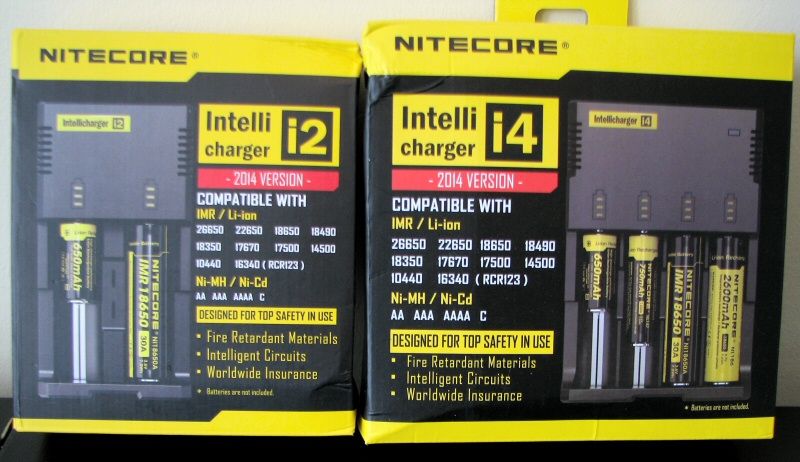
Note the big "2014 VERSION" in red on the boxes above.
Has much changed from the previous version? For that, let's see how the results compare to my earlier i4 V2 review.
The i4 generated a lot of interest when it first came out, given its stated ability to "intelligently" handle both Li-ions and standard NiMH/NiCd rechargeable batteries. It does this by detecting the voltage of the cells when you insert them, and then applies the appropriate charge algorithm.
As always, I freely admit that I am not as well versed in electronics or circuitry as some of the other members here. So I suggest you consult with the true experts in this forum if you want to know more than just the basic current/voltage runtime relationships that I can measure here. Speaking of which, I am following HKJ's excellent Measurement on Flashlight methods for the current/voltage testing.
So let's see what the specs have to say for each model.
I4 2014

Nitecore i4 2014 Reported Specifications

Nitecore i4 2014 Reported Specifications
I4 2014
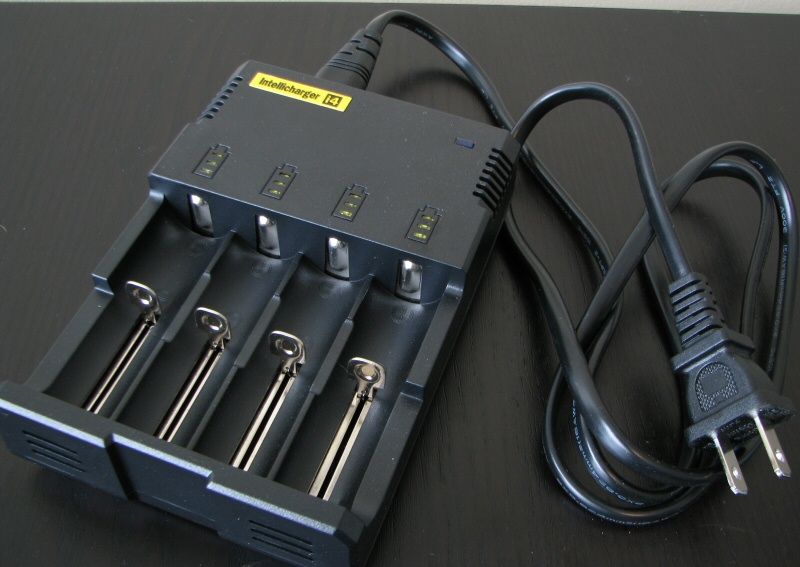
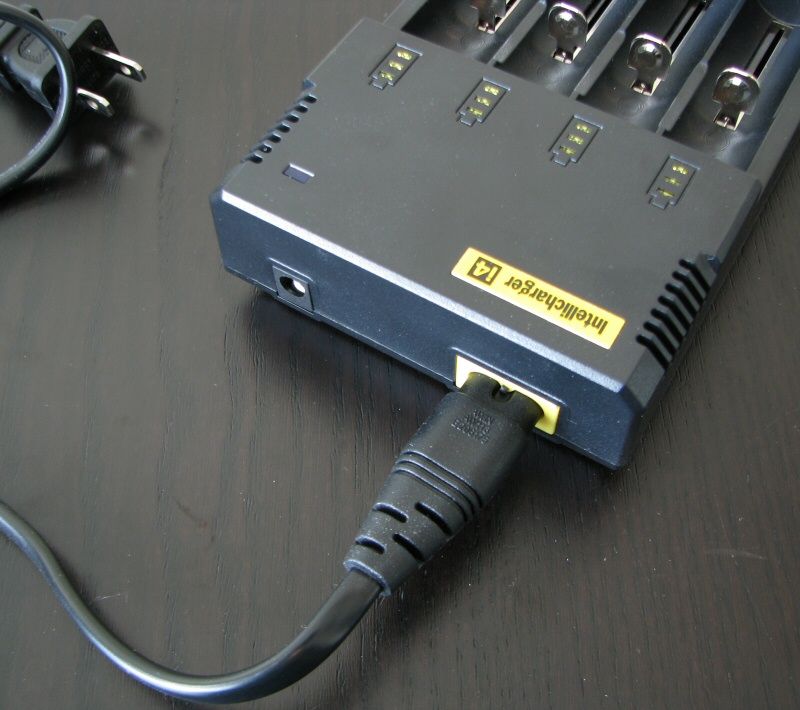
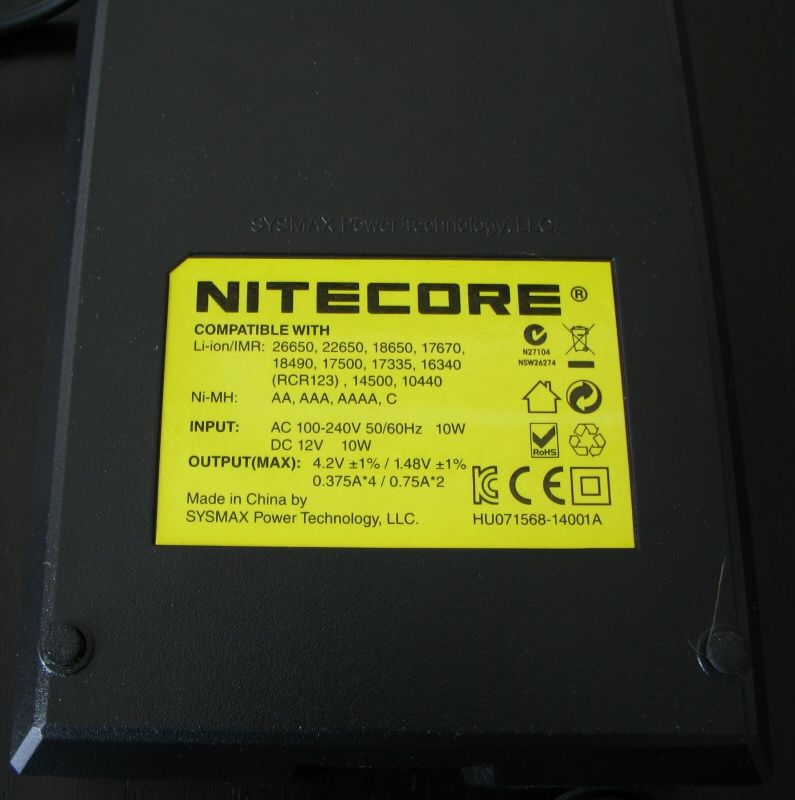
I2 2014
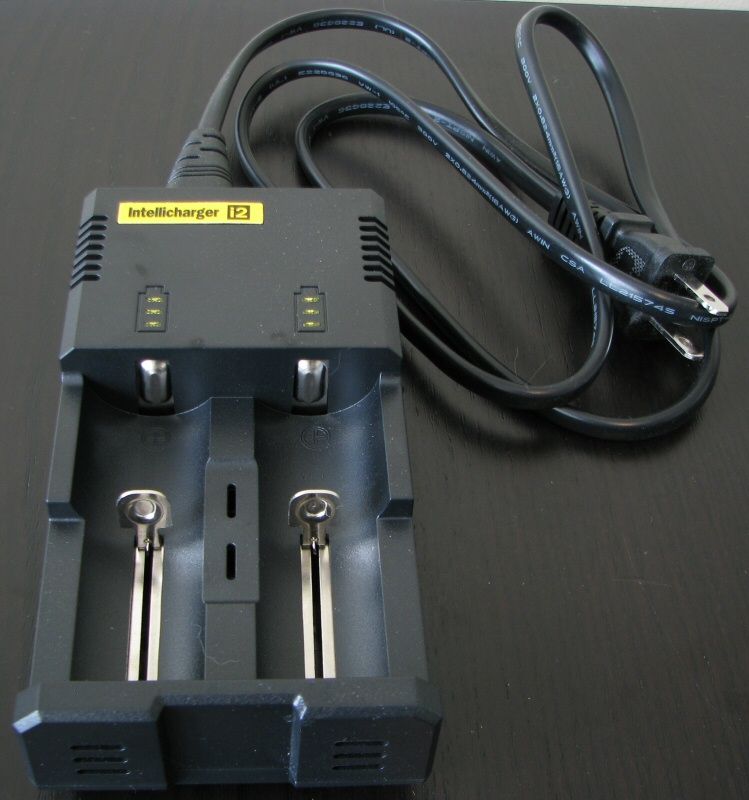
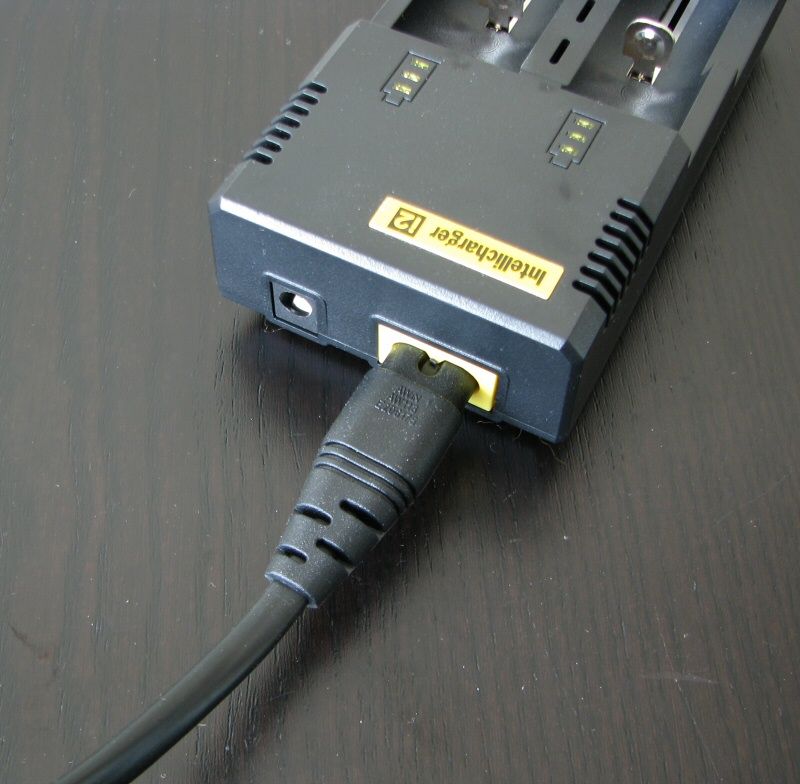
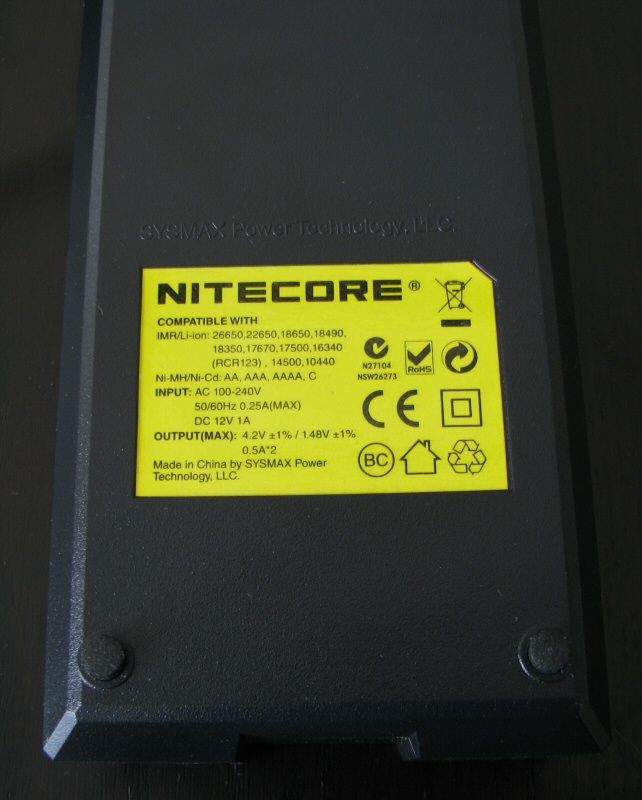
My samples both came with a standard 110 AC power adapter designed to North American plugs. The units support 100 – 240V AC, 50/60Hz, so those outside of North America can use it fine (with the appropriate terminal plug). A 12V DC car adapter is available separately.
A key point to specs above is that while the i2 has two independent channels (for 500mA), the i4 also only has two channels (but for up to 750mA). Since the i4 actually has four wells, that means that current needs to be shared between two wells. While the charger label reports this as "0.375A*4", in actual fact the charger remains at 750mA for each bay – but it alternates charging by cycling off/on about once every second for each battery. This effectively results in the same thing, but the cell is actually being charged at 750mA for a 1sec on, 1sec off, cycle.
Unfortunately, Nitecore still does not identify which of the four wells are paired in this fashion on the i4. As before, I determined from my testing that the paired wells are #1 & #3 and #2 & #4 (i.e., paired wells are separated by an independent well in between).
As before, the cabling and overall build of the units seem good (i.e., good length on the cables, solid base unit).
The most obvious visual difference for the new 2014 models is the presence of the metal rail for the battery slider. Previously, these were just spring-mounted (and often poorly lubed). As a result, I find the spring action a lot smoother on these new 2014 models. :thumbsup:
The units can accommodate a range of cells, although wide cells (i.e., 26650) will need to go into the outside wells of the i4 to make proper contact. Note that the overall size of the chargers hasn't changed, so you will find it a bit tight to get some really long protected cells in there. Personally, I would have liked to have seen them extend the units by a mm or two. :shrug:
To give you an idea what the units look like with cells installed:
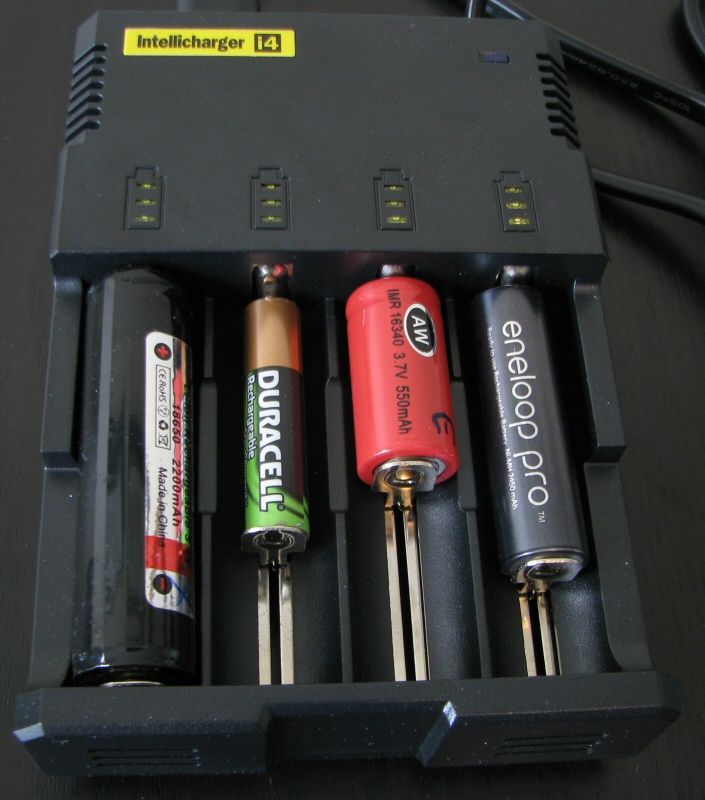
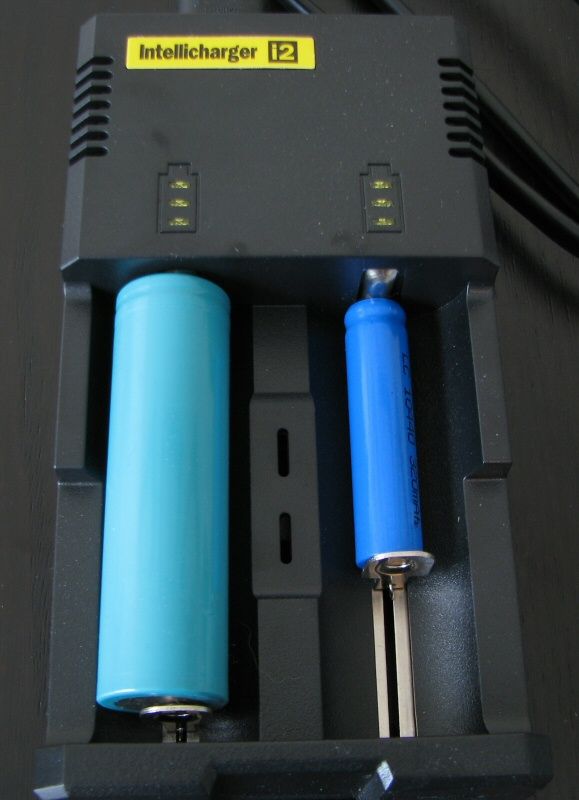
Note: I didn't have the unit plugged in for these shots, which is why you don't see any of the indicator lights lit up.
There are three yellow lights located over each charging bay, and a blue power indicator at the top right hand side of the unit (lights up when AC/DC power is supplied).
When you insert a battery into the charger, the three yellow lights over the bay indicate the charging status by the number of flashing LEDs (counting from the bottom up). Three solid LEDs means the battery is fully charged and the unit has stopped charging (in theory – scroll down for a discussion on NiMH).
Here is a quick video overview of the physical builds of the chargers:
Voltage/Current Measurements
To examine the performance of the chargers, I have directly monitored charging current and voltage with a data-logging DMM - but on separate runs. While plotted together, these means the voltage and current traces may not exactly correspond in time.
For these tests, I have used my standard AW protected 18650 (2200mAh) and Sanyo Eneloop AA NiMH (2000mAh). The cells used here have all had a good number of cycles on them, but are still in reasonable condition. Drained batteries (typically resting voltage typically ~3.0-3.2V) are used for these tests.

The i4 2014 shows a good simulated constant-current/constant-voltage (CC/CV) algorithm, as before. The specific voltage run above had a few restarts during the constant current (CC) phase, and took a bit longer on the constant voltage (CV) phase, so I would go with the current run as the best indicator of typical performance (on 2200mAh cells).
As you can see above, the i4 2014 terminated at 28mA with a resting voltage of ~4.21V. This is very similar to my original i4 V2 review. The termination current is a bit lower now, and the resting voltage a bit higher (resulting in slightly longer charging time). But that could just be variability between charger samples.
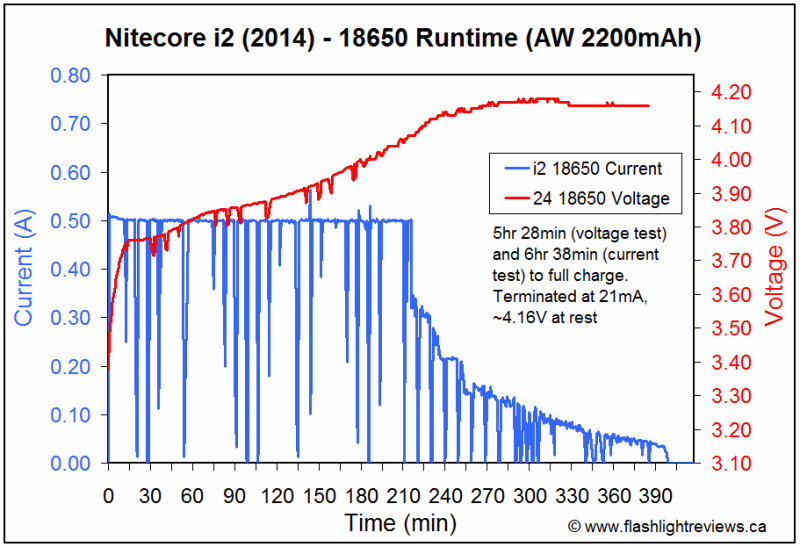
The i2 2014 similarly has a good CC/CV charging algorithm. While the charging current is not as high as the i4 2014 in the CC phase, it doesn't seem to drop off as rapidly in the CV phase (although that could be a bit of battery variability). Again, the current run above seems the most representative of what you can expect for this unit (i.e., it takes longer to fully charge an 18650 than the i4). Termination level is again good.
FYI, the "dips" in the graphs above have to do with how the chargers operate – they actually pause charging once every two seconds (presumably to check the battery voltage). Not sure why they both do this, but it's been a common feature of these models from the beginning. My sampling rate is once every 30 secs above, hence the why you don't see a continuous "wall of noise", but just sporadic dips (i.e., on the odd times when the sampling took place during a charging pause).
I haven't bother showing what the paired charging would like, or RCR cells, but you can see my earlier i4 V2 review for that. Effectively, it may take up to twice as long to charge cells in paired channel bays.
So how does NiMH look?
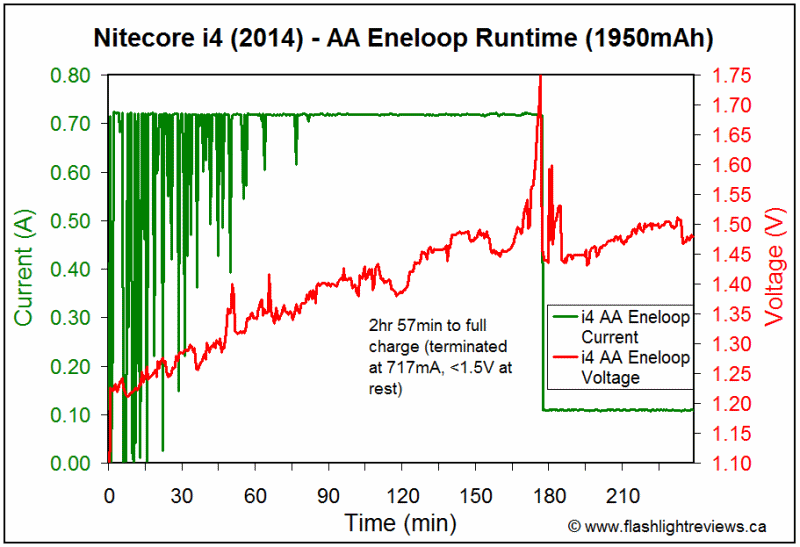
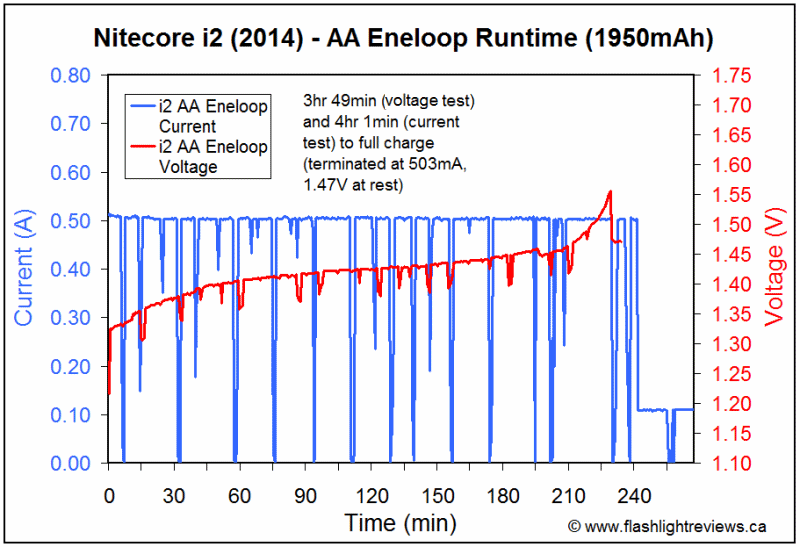
The chargers run at their max CC cycle initially. I am not sure of the termination method being used, but it looks like it could simply be based on cell voltage. The recommended termination method for NiMH is dV/dT, which is based on a characteristic increase in the positive slope of voltage versus time. As before, this does not seem to be the case here.
Again, due to the lower charging current per channel, the i2 will take longer than the i4 to charge NiMH batteries.
But there is something different about the new 2014 versions and NiMH charging – when the charger "terminates", it actually drops to a ~110mA continuous "trickle charge". This appears to be the way the charger makes up for the voltage-based termination method (which may leave the batteries somewhat undercharged), by providing a prolonged lower-level "trickle charge".
Nitecore informs that that the "trickle charge" is normal to maintain the charge status of the NiMH batteries, and won't harm the cells. But it would NOT be a good idea to leave these cells in there too long after the charging status indicates they are done. I would recommend you pull the cells within an hour so of the "termination" notice.
The full charge capacity seems to be good on both chargers, if you give them that extra hour or so of "trickle charge". My Maha C9000 charger reports a typical discharge capacity to these cells (upon subsequent discharge), comparable to my Maha's own charge cycle performance.
FYI, you can safely charge NiMH and Li-ions at the same time, even in paired bays.
As with all chargers, your cells will slowly drain if left in the unit without power. I measured the at-rest drain (when not connected to AC power) on the i2 2014 as 1.4mA for Li-ion, and 0.06mA for NiMH. For the i4 2014, I measured 0.77mA on Li-ion, and 0.15mA on NiMH.
One last comment – these new units seem to take a little longer to actually start charging than the previous models. While the indicator lights come on as quickly as before, I measured a lower initial current of ~125mA for about 10-20 secs or on each model, on all batteries, before jumping up to the max rated current. :shrug: Note sure why this is, but it is another sign of a circuit change from the earlier versions.
Preliminary Discussion
The Nitecore Intellicharger line has been popular here since their initial release – likely due to their dual support of both Li-ions and NiMH batteries. Physically, I can only see the improved battery rail in each well, but I can infer internal circuit changes as well. The new rail is definitely an improvement over the older springs – I found the slide action noticeably smoother now. :thumbsup:
On Li-ions, overall performance seems similar to the early versions, with a good CC/CV-like algorithm (and with a nice and low charging rate at termination).
NiMH charges with a consistent constant max current, but seems to use a simple voltage measure for the termination signal (as opposed to the recommended dV/dt). One thing that is new for the 2014 models is that Nitecore has added a ~110mA "trickle charge" to the NiMH algorithm, to help ensure that the cells wind up being fully charged. This is necessary due to the simple termination method used (which may under-estimate charge status). Unfortunately, this means that the batteries are still charging after the indicator lights indicate charging is over – which is not something I like to see. :shrug:
It is hard to say how long you should let the charger continue charging the NiMH cells beyond the indicator "termination" – but I recommend you pull them within an hour or so. Certainly, you wouldn't want to leave them in there over days, as this may wear them down eventually. Better to have slightly undercharged cells than overcooked ones!
In terms of choosing between the two models, it largely comes down to what your needs are. The i4 has a larger max charging current, leading to shorter charging times. However, the i2 would be more suitable for lower capacity cells (e.g., RCR, 14500, and AAA), due to the slightly lower charging current. Effectively, both units can only fully charge two wells at a time (i.e., the i4 has to alternate the current between paired wells).
Physically, there is a little more space to accommodate wider batteries in the i2 (e.g. 26650) – but the i4 is still serviceable in this regard, if you use the outside wells. Both models are still tight for length with protected cells - I would prefer to see Nitecore add an extra mm or two to well height on both models.
At the end of the day, these are incremental upgrades to the Intellicharger line from Nitecore. I think these chargers still offer good value for the money - especially compared to discount "budget" chargers that cost almost as much, but with unknown charging algorithms. They are also particularly useful for less sophisticated users who are just starting to use Li-ions (and may thus inadvertently try to charge NiMH and Li-ion on the same device - a real no-no on just about every other charger!).
But there are certainly better dedicated NiMH chargers out there. And the Li-ion charger market has expanded a lot in recent years too. There are now more sophisticated chargers that cost more but offer significant additional features (e.g., the option to set the max charge current, or read out battery voltage during charging). If you need a dedicated Li-ion-only charger, you may want to consider investing a bit more for an expanded feature set. But if you want combined Li-ion/NiMH support (and at a reasonable price), the i4 and i2 seem to continue to fit the bill.
----
i4 and i2 2014 chargers were supplied by Ntecore for review.
:wave:
This is a review of the newly revised for 2014 editions of the Nitecore Intellicharger i2 and i4. Please see my earlier review of the previous i4 V2 from 2012.

Note the big "2014 VERSION" in red on the boxes above.
Has much changed from the previous version? For that, let's see how the results compare to my earlier i4 V2 review.
The i4 generated a lot of interest when it first came out, given its stated ability to "intelligently" handle both Li-ions and standard NiMH/NiCd rechargeable batteries. It does this by detecting the voltage of the cells when you insert them, and then applies the appropriate charge algorithm.
As always, I freely admit that I am not as well versed in electronics or circuitry as some of the other members here. So I suggest you consult with the true experts in this forum if you want to know more than just the basic current/voltage runtime relationships that I can measure here. Speaking of which, I am following HKJ's excellent Measurement on Flashlight methods for the current/voltage testing.
So let's see what the specs have to say for each model.
I4 2014

Nitecore i4 2014 Reported Specifications
- Input: AC 100-240V 50/60Hz 0.35A(MAX) or DC 12V 1A
- Output voltage: 4.2V ±1% / 1.48V ±1%
- Output current: 375mA × 4 / 750mA × 2
- Dimensions: 138mm × 95mm × 36mm
- Weight: 184g (without batteries and power cord)
- Compatible with:
- Li-ion / IMR: 26650, 22650, 18650, 17670, 18490, 17500, 18350, 16340(RCR123), 14500, 10440
- Ni-MH / Ni-Cd: AA, AAA, AAAA, C
- Capable of charging 4 batteries simultaneously
- MSRP: ~$20-25

Nitecore i4 2014 Reported Specifications
- Input : AC 100-240V 50/60Hz 0.25A(MAX) or DC 12V 1A
- Output voltage: 4.2V ±1% / 1.48V ±1%
- Output current: 500mA × 2
- Dimensions: 131mm × 69mm × 36mm
- Weight: 116g (without batteries and power cord)
- Compatible with:
- Li-ion / IMR: 26650, 22650, 18650, 17670, 18490, 17500, 18350,
16340(RCR123), 14500, 10440 - Ni-MH / Ni-Cd: AA, AAA, AAAA, C
- Capable of charging 2 batteries simultaneously
- MSRP: ~$15-20
- Each of the battery slots monitors and charges independently
- Optimized charging design for IMR batteries
- Features three charging modes (CC, CV and Trickle Charge)
- Automatically detects battery status and selects the appropriate voltage and charge mode
- 3 Color LED displays charging progress for each battery
- Automatically stops charging when complete
- Features over-charge prevention to protect batteries
- Features temperature monitoring to prevent overheating
- Made from durable ABS (fire retardant / flame resistant)
- Features reverse polarity protection
- Designed for optimal heat dissipation
- Certified by RoHS, CE, FCC, CEC and KC
- Insured worldwide by Ping An Insurance (Group) Company of China, Ltd
I4 2014



I2 2014



My samples both came with a standard 110 AC power adapter designed to North American plugs. The units support 100 – 240V AC, 50/60Hz, so those outside of North America can use it fine (with the appropriate terminal plug). A 12V DC car adapter is available separately.
A key point to specs above is that while the i2 has two independent channels (for 500mA), the i4 also only has two channels (but for up to 750mA). Since the i4 actually has four wells, that means that current needs to be shared between two wells. While the charger label reports this as "0.375A*4", in actual fact the charger remains at 750mA for each bay – but it alternates charging by cycling off/on about once every second for each battery. This effectively results in the same thing, but the cell is actually being charged at 750mA for a 1sec on, 1sec off, cycle.
Unfortunately, Nitecore still does not identify which of the four wells are paired in this fashion on the i4. As before, I determined from my testing that the paired wells are #1 & #3 and #2 & #4 (i.e., paired wells are separated by an independent well in between).
As before, the cabling and overall build of the units seem good (i.e., good length on the cables, solid base unit).
The most obvious visual difference for the new 2014 models is the presence of the metal rail for the battery slider. Previously, these were just spring-mounted (and often poorly lubed). As a result, I find the spring action a lot smoother on these new 2014 models. :thumbsup:
The units can accommodate a range of cells, although wide cells (i.e., 26650) will need to go into the outside wells of the i4 to make proper contact. Note that the overall size of the chargers hasn't changed, so you will find it a bit tight to get some really long protected cells in there. Personally, I would have liked to have seen them extend the units by a mm or two. :shrug:
To give you an idea what the units look like with cells installed:


Note: I didn't have the unit plugged in for these shots, which is why you don't see any of the indicator lights lit up.

There are three yellow lights located over each charging bay, and a blue power indicator at the top right hand side of the unit (lights up when AC/DC power is supplied).
When you insert a battery into the charger, the three yellow lights over the bay indicate the charging status by the number of flashing LEDs (counting from the bottom up). Three solid LEDs means the battery is fully charged and the unit has stopped charging (in theory – scroll down for a discussion on NiMH).
Here is a quick video overview of the physical builds of the chargers:
Voltage/Current Measurements
To examine the performance of the chargers, I have directly monitored charging current and voltage with a data-logging DMM - but on separate runs. While plotted together, these means the voltage and current traces may not exactly correspond in time.
For these tests, I have used my standard AW protected 18650 (2200mAh) and Sanyo Eneloop AA NiMH (2000mAh). The cells used here have all had a good number of cycles on them, but are still in reasonable condition. Drained batteries (typically resting voltage typically ~3.0-3.2V) are used for these tests.

The i4 2014 shows a good simulated constant-current/constant-voltage (CC/CV) algorithm, as before. The specific voltage run above had a few restarts during the constant current (CC) phase, and took a bit longer on the constant voltage (CV) phase, so I would go with the current run as the best indicator of typical performance (on 2200mAh cells).
As you can see above, the i4 2014 terminated at 28mA with a resting voltage of ~4.21V. This is very similar to my original i4 V2 review. The termination current is a bit lower now, and the resting voltage a bit higher (resulting in slightly longer charging time). But that could just be variability between charger samples.

The i2 2014 similarly has a good CC/CV charging algorithm. While the charging current is not as high as the i4 2014 in the CC phase, it doesn't seem to drop off as rapidly in the CV phase (although that could be a bit of battery variability). Again, the current run above seems the most representative of what you can expect for this unit (i.e., it takes longer to fully charge an 18650 than the i4). Termination level is again good.
FYI, the "dips" in the graphs above have to do with how the chargers operate – they actually pause charging once every two seconds (presumably to check the battery voltage). Not sure why they both do this, but it's been a common feature of these models from the beginning. My sampling rate is once every 30 secs above, hence the why you don't see a continuous "wall of noise", but just sporadic dips (i.e., on the odd times when the sampling took place during a charging pause).
I haven't bother showing what the paired charging would like, or RCR cells, but you can see my earlier i4 V2 review for that. Effectively, it may take up to twice as long to charge cells in paired channel bays.
So how does NiMH look?


The chargers run at their max CC cycle initially. I am not sure of the termination method being used, but it looks like it could simply be based on cell voltage. The recommended termination method for NiMH is dV/dT, which is based on a characteristic increase in the positive slope of voltage versus time. As before, this does not seem to be the case here.
Again, due to the lower charging current per channel, the i2 will take longer than the i4 to charge NiMH batteries.
But there is something different about the new 2014 versions and NiMH charging – when the charger "terminates", it actually drops to a ~110mA continuous "trickle charge". This appears to be the way the charger makes up for the voltage-based termination method (which may leave the batteries somewhat undercharged), by providing a prolonged lower-level "trickle charge".
Nitecore informs that that the "trickle charge" is normal to maintain the charge status of the NiMH batteries, and won't harm the cells. But it would NOT be a good idea to leave these cells in there too long after the charging status indicates they are done. I would recommend you pull the cells within an hour so of the "termination" notice.
The full charge capacity seems to be good on both chargers, if you give them that extra hour or so of "trickle charge". My Maha C9000 charger reports a typical discharge capacity to these cells (upon subsequent discharge), comparable to my Maha's own charge cycle performance.
FYI, you can safely charge NiMH and Li-ions at the same time, even in paired bays.
As with all chargers, your cells will slowly drain if left in the unit without power. I measured the at-rest drain (when not connected to AC power) on the i2 2014 as 1.4mA for Li-ion, and 0.06mA for NiMH. For the i4 2014, I measured 0.77mA on Li-ion, and 0.15mA on NiMH.
One last comment – these new units seem to take a little longer to actually start charging than the previous models. While the indicator lights come on as quickly as before, I measured a lower initial current of ~125mA for about 10-20 secs or on each model, on all batteries, before jumping up to the max rated current. :shrug: Note sure why this is, but it is another sign of a circuit change from the earlier versions.
Preliminary Discussion
The Nitecore Intellicharger line has been popular here since their initial release – likely due to their dual support of both Li-ions and NiMH batteries. Physically, I can only see the improved battery rail in each well, but I can infer internal circuit changes as well. The new rail is definitely an improvement over the older springs – I found the slide action noticeably smoother now. :thumbsup:
On Li-ions, overall performance seems similar to the early versions, with a good CC/CV-like algorithm (and with a nice and low charging rate at termination).
NiMH charges with a consistent constant max current, but seems to use a simple voltage measure for the termination signal (as opposed to the recommended dV/dt). One thing that is new for the 2014 models is that Nitecore has added a ~110mA "trickle charge" to the NiMH algorithm, to help ensure that the cells wind up being fully charged. This is necessary due to the simple termination method used (which may under-estimate charge status). Unfortunately, this means that the batteries are still charging after the indicator lights indicate charging is over – which is not something I like to see. :shrug:
It is hard to say how long you should let the charger continue charging the NiMH cells beyond the indicator "termination" – but I recommend you pull them within an hour or so. Certainly, you wouldn't want to leave them in there over days, as this may wear them down eventually. Better to have slightly undercharged cells than overcooked ones!
In terms of choosing between the two models, it largely comes down to what your needs are. The i4 has a larger max charging current, leading to shorter charging times. However, the i2 would be more suitable for lower capacity cells (e.g., RCR, 14500, and AAA), due to the slightly lower charging current. Effectively, both units can only fully charge two wells at a time (i.e., the i4 has to alternate the current between paired wells).
Physically, there is a little more space to accommodate wider batteries in the i2 (e.g. 26650) – but the i4 is still serviceable in this regard, if you use the outside wells. Both models are still tight for length with protected cells - I would prefer to see Nitecore add an extra mm or two to well height on both models.
At the end of the day, these are incremental upgrades to the Intellicharger line from Nitecore. I think these chargers still offer good value for the money - especially compared to discount "budget" chargers that cost almost as much, but with unknown charging algorithms. They are also particularly useful for less sophisticated users who are just starting to use Li-ions (and may thus inadvertently try to charge NiMH and Li-ion on the same device - a real no-no on just about every other charger!).
But there are certainly better dedicated NiMH chargers out there. And the Li-ion charger market has expanded a lot in recent years too. There are now more sophisticated chargers that cost more but offer significant additional features (e.g., the option to set the max charge current, or read out battery voltage during charging). If you need a dedicated Li-ion-only charger, you may want to consider investing a bit more for an expanded feature set. But if you want combined Li-ion/NiMH support (and at a reasonable price), the i4 and i2 seem to continue to fit the bill.
----
i4 and i2 2014 chargers were supplied by Ntecore for review.

